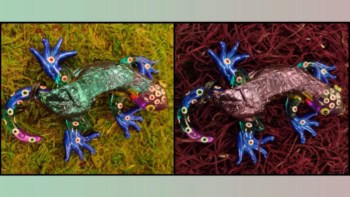
“Smart paint” containing fluorescent and phosphorescent pigments could extend the possibilities of proposed LiFi networks, report a team led by K S Narayan at the Jawaharlal Nehru Centre for Advanced Scientific Research in Bengaluru, India. The researchers analysed the effect of nearby luminescent surfaces on the noise characteristics of visible light communication system (VLC) signals, and found that secondary emission could limit bandwidth locally by overwhelming receivers. The residual glow from phosphors could even be modulated to transmit a signal after the primary LED source has been turned off.
Visible improvement
LiFi uses visible and near-visible light to connect electronic devices in much the same way as now nearly ubiquitous WiFi. Like its more familiar counterpart, LiFi technology is expected to play a role in connecting devices within the incipient internet of things. Unlike microwaves, however, visible-light signals cannot pass through walls, meaning that LiFi networks are, in principle, less vulnerable to eavesdropping from outside.
It has already been established that VLCs can operate without line-of-sight contact between transmitters and receivers, since sufficiently high signal-to-noise ratios can be retained in light reflected from surfaces in the local environment. Now, Narayan and his team have investigated the situation for more complex arrangements, in which a luminescent component is superimposed on the primary signal.
The researchers measured the noise in the signal transmitted directly by the LED, and compared it with that contained in the signal mediated by fluorescent and phosphorescent surfaces. The period between excitation and de-excitation in fluorescent materials is shorter than the interval between concurrent photons in the signal, so fluorescent pigments near the detector preserved the Gaussian noise distribution of the incident light.
The strontium aluminate which Narayan and colleagues used as a phosphor, on the other hand, exhibits a much slower response. This had a marked effect on the measured photon number fluctuations, as Narayan explains: “In bright phosphors, light persists for several hours after the pump-photoexcitation. This phosphor light source serves as an independent emitter, wiping out the history of photoexcitation-information (modulation). The phosphor-emitted light appears as a noise component in a signal which consists of the direct line-of-sight-pump and the phosphor part.”
Signal jamming
The ability to change the photon number distribution means that phosphor-containing paints could be used to mask the modulated signal locally. “You can restrict the LiFi usage selectively,” continues Narayan. “LiFi is supposedly for secure communication indoors, and now we can further introduce spaces in a LiFi-enabled room where signal-bandwidth is restricted for users. Even if the room is well lit, one can have regions with these paints which can sort of jam the signals.”
As well as allowing enhanced network security, the long-lived phosphorescent effect also suggested to Narayan and his team an opportunity for energy harvesting. Although the primary signal does not persist in the phosphor-emitted light, the researchers showed that information can be encoded in the residual emission using an acousto-optic modulator. This means that data can continue to be transferred even after the LED has been switched off.
Full details of the research are reported in Journal of Optics.



